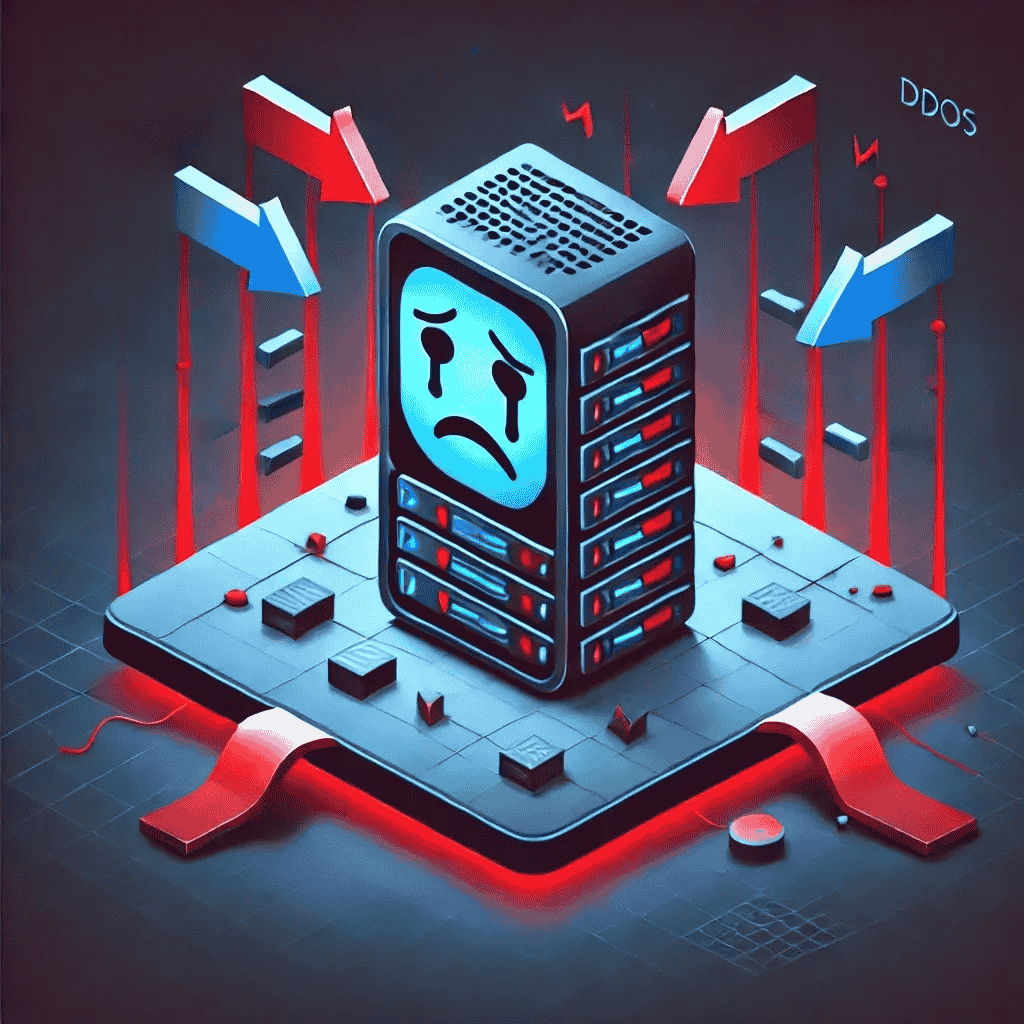In this article, we will take a closer look at two of the most common types of cyber threats: web exploits and DDoS attacks (Distributed Denial of Service).
Understanding Web Exploits: A Peek Behind the Digital Curtain
Web exploits are the digital equivalent of leaving your backdoor unlocked, only to find a cheeky rogue rummaging through your most prized possessions. These crafty attacks exploit weaknesses in web applications, infrastructure, or even the users themselves.

🎯 Core Idea: Web exploits don’t discriminate—they’ll hit anything from your pocket-sized smartphone to massive cloud infrastructures. Ignoring them? That’s asking for trouble.
A successful web exploit isn’t just a glitch—it’s a full-blown disaster. One moment, your system is running smoothly, the next—attackers are digging through sensitive data, shutting down services, or even hijacking entire networks. And trust me, once they’re in, they won’t be sending thank-you notes.
That’s why knowing how to spot, block, and shut down web exploits isn’t just important—it’s survival, and here is when cybersecurity sets the stage. 🚀
DDoS Attacks: Digital Mayhem, One Packet at a Time?
If web exploits are a sneaky burglar, Distributed Denial of Service (DDoS)attacks are a rugby team storming your front gate. DDoS attacks overwhelm your servers with traffic until they cry for mercy—or crash entirely.

🛡 How It Works:
- Tens of thousands of requests flood your server.
- It chokes, it sputters, and then… boom. Offline.
- Your users are livid, and your reputation takes a nosedive.
DDoS is less about finesse and more about brute force, but the damage is all too real.
A Closer Look at Online Threats
| Threat | What it Does | How to Stay Safe |
| Malware | Digital parasites infect your system, steal data, or turn your machine into a botnet zombie. | Keep software updated, use antivirus, and don’t download shady files. |
| Phishing | Scammers impersonate legitimate sources to trick you into handing over passwords, credit card info, or worse. | Verify emails, don’t click random links, use email filters. |
| DDoS Attack | A flood of traffic hits your server like a digital riot, causing downtime and chaos. | Use DDoS protection (Cloudflare, AWS Shield), rate limiting, and load balancing. |
| SQL Injection | Attackers inject malicious SQL queries to manipulate your database, steal data, or drop tables. | Use prepared statements, input validation, and firewall rules. |
| Ransomware | Locks up your data and demands a fat ransom to get it back. Pay or lose everything. | Regular backups, security patches, endpoint protection. |
| XSS (Cross-Site Scripting) | Injects malicious scripts into web apps to steal session cookies or take control of user accounts. | Sanitize inputs, and use a Content Security Policy (CSP). |
| MitM (Man-in-the-Middle) | Hackers eavesdrop on or alter communication between two parties, intercepting sensitive data. | Use HTTPS, VPNs, and public key encryption. |
| Brute Force Attack | Hackers try endless password combinations until they crack your login like a safe. | Strong passwords, multi-factor authentication (MFA), and account lockouts. |
| Zero-Day Exploit | Attacks on unknown vulnerabilities before a patch even exists. Basically, digital espionage. | Patch fast, use threat intelligence, run intrusion detection. |
| Social Engineering | Instead of hacking machines, they hack people—tricking employees into handing over sensitive data. | Security awareness training, verify identities, limit access. |
| Data Breach | Sensitive data gets leaked, sold, or exposed, leading to financial and reputational damage. | Strong encryption, access control, and regular security audits. |
These threats are like pub brawlers—each has its nasty tricks, but all aim to knock you out.
Web Application Security: Your Digital Fortress

Every web application is a potential target. And like a proper British castle, it needs layers of protection:
- Encryption: Keep your secrets locked away.
- Authentication: Know who’s knocking at the gate.
- Regular Updates: Don’t let the walls crumble.
And remember: defending a castle isn’t a one-time task—it’s a lifelong commitment.
Network Security: The Lifeline of Your Digital Kingdom
Your applications might be the face, but the network is the lifeblood.
Protect it like a true knight with firewalls, encryption, and constant vigilance.
As an Irish proverb says, “Better be safe than sorry.”

- Educate your team: An uninformed user is a hacker’s best mate.
- Fortify your defenses: From apps to networks, leave no stone unturned.
- Leverage the cloud: AWS Shield, WAFs, and more—don’t just install them, master them.
The digital battlefield is always changing. But as my gran used to say, “Forewarned is forearmed.” So sharpen your skills and keep your guard up.
Cloud Security: Who’s Got Your Back?
Cloud platforms are like fortresses, but even the best defenses are useless if you don’t know how to wield them. Let’s break down how AWS, Azure, GCP, and OCI stack up when it comes to DDoS defense and web exploit protection.
| AWS | Azure | GCP | OCI | |
| DDoS Protection | AWS Shield | Azure DDoS Protection | Google Cloud Armor | OCI Web Application Firewall |
| Web Exploits | AWS WAF | Azure Web App Firewall | Google Cloud Web Security Scanner | OCI Web Application Firewall |
| Mitigation Tactics | Auto-scaling, IP Reputation, Anycast, BGP Flowspec | Auto-scaling, Azure DDoS Protection | Load Balancing, Security Policies | Threat Intelligence, Regular Updates |
| Services | AWS Shield, Auto Scaling, CloudFront | Azure Front Door, Traffic Manager | Google Cloud Load Balancing, Cloud Armor | OCI Web Application Firewall |
AWS: The Cybersecurity War Machine
AWS doesn’t mess around—it arms users with a battle-ready toolkit to fend off cyberattacks:
🔹 AWS Shield — Automated DDoS protection that absorbs large-scale attacks like a digital sponge.
🔹 AWS Web Application Firewall (WAF) — Blocks common web exploits before they can even touch your app.
And that’s just the tip of the iceberg. AWS also rolls out:
✅ IAM (Identity and Access Management) — Lock down access before hackers even think about knocking.
✅ Encryption Protocols — Because plaintext data is an invitation to disaster.
✅ Security Groups & Network Access Controls — Who gets in, who stays out—it’s all under your control.
⚠️ Warning: AWS hands you the weapons, but if you don’t configure them right, you might as well be fighting with a Nerf gun.
Azure: The Guardian of the Cloud Realm
Microsoft Azure isn’t just about hosting—it’s about surviving in the wild:
🔹 Azure DDoS Protection — Auto-mitigates DDoS threats before they cripple your services.
🔹 Azure Application Gateway (WAF) — Stops web exploits in their tracks like a digital firewall bouncer.
Extra security muscle includes:
✅ Role-Based Access Control (RBAC) — No more “oops, I gave admin access to an intern.”
✅ Azure Security Center — A control tower for monitoring threats and vulnerabilities.
✅ Azure Key Vault — Store secrets like you’re MI6.
💡 Pro Tip: Azure gives you the tools, but configuring them correctly is the difference between sleeping soundly and waking up to a security breach.
GCP: Google’s Cyber Shields
Google Cloud Platform (GCP) doesn’t just handle searches—it defends your digital empire:
🔹 Google Cloud Armor — DDoS protection and application-layer defense packed into one beastly tool.
🔹 Cloud Security Scanner — Think of it as Google’s “X-ray vision” for vulnerabilities in your apps.
Additional layers of security include:
✅ IAM (Identity and Access Management) — Keep access locked down tighter than a bank vault.
✅ Encryption Mechanisms — Because unprotected data is just an all-you-can-eat buffet for hackers.
✅ Virtual Private Cloud (VPC) Service Controls — Control traffic like a cybersecurity air-traffic controller.
💀 Bottom Line: GCP has solid security, but only if you know how to configure and monitor it properly.
OCI: Oracle’s Digital Fortress
Oracle Cloud Infrastructure (OCI) might not be as mainstream as AWS, but it packs a serious punch:
🔹 DDoS Protection — Built-in defense against traffic floods and botnets.
🔹 Oracle Web Application Firewall (WAF) — A security gatekeeper blocking malicious web requests.
Other key features:
✅ IAM (Identity and Access Management) — Fine-tune who gets access to what.
✅ Encryption & Security Lists — Because data leaks are not a flex.
🔎 Reality Check: Even the best security tools won’t save you if you’re not actively monitoring threats.
Cloud Security: Tools Are Only Half the Battle
All these platforms offer solid defenses, but at the end of the day, it’s on you to architect, configure, and monitor them properly. A misconfigured firewall, a forgotten security update, or weak access policies can turn even the most secure cloud into a hacker’s playground.
🔹 Lesson? Don’t just use security tools—master them. Stay ahead of threats, automate defenses, and keep learning. Because in cybersecurity, the best defense is a damn good offense. 🚀
